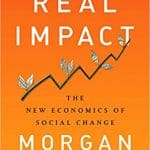Less Golf, More Gender Equity: A Q&A with Impact Investor Morgan Simon
Though impact investing’s entry into the mainstream may be a recent development, Morgan Simon’s career in the space is anything but. Having long merged finance with social justice activism in a wide variety of roles – most recently as an author and a founding partner at the sustainable investing firm Candide Group – her resume is extensive and her work inarguably influential.
However, her impact-focused path has not been without challenges, including times when, as she mentioned in a recent Forbes article, she downplayed her gender “to be taken seriously in a male-dominated industry.”
NextBillion caught up with Simon to discuss her work, and how her gender has influenced many of the steps along the way to her current success. In the Q&A below, she shares valuable insights for those hoping to follow in her footsteps – particularly young women – and for firms aiming to apply an intersectional, inclusive focus to their work.
Katie Beasley: You currently serve as a founding partner of Candide Group, an organization that “designs capital strategies for a complex world in need of transformation.” How did you first get involved in the impact investing world, and what has motivated you to stay involved with the sector for so long?
Morgan Simon: I have been an impact investor for close to 20 years. Compared to many of my peers I got a very early start—filing shareholder resolutions using my college’s endowment when I was 19 years old. I then went on to serve as Founding Executive Director of the Responsible Endowments Coalition, Founding CEO of Toniic, Co-Founder of Transform Finance, and most recently, for the past six years I’ve served as Founding Partner of Candide Group alongside Aner Ben-Ami. Together we’ve supported over 65 companies and funds on behalf of a diverse community ranging from Pritzker family members to NFL player Derrick Morgan. So as much as I’m an investor, I would say I’ve always been an entrepreneurial one, building infrastructure for the impact investment community, and focused on the nexus between social justice and social investing.
But even before then, I was always an activist. I grew up in Los Angeles, a city with a racial and economic wealth gap several hundred miles wide. I learned from a young age the difference between charity—treating people as less than you—versus solidarity—treating people as you would your own family. I grew up in a white, middle-class, Jewish family in the Valley, and had deep relationships with very low-income Latinx families in downtown LA. I saw that their lack of economic autonomy often led to a lack of social, political and cultural autonomy. I got into economic activism because I saw it as such a fundamental building block of social organization. To this day, as much as I love all the companies and funds we support, my broader goal is to change the culture of money so that capital first and foremost works for people—and not the other way around.
KB: Certainly, the gender landscape has changed much since you began your career in impact investing. If you had to choose one, what would you name as the most pivotal shift you’ve witnessed, as it relates to gender, in the sector?
MS: The greatest shift I’ve seen, from when SRI was overwhelmingly populated in the ‘80s and ‘90s by white hippies and radical nuns, is the emergence of so many women of color doing amazing work in the sector: women like Kesha Cash, Nathalie Molina Niño, Jo Opot, Maya Horgan Famodu, Irma Olguin, Stefanie Thomas, Natalie Oberti Noguera, Lauren Booker Allen, Arlan Hamilton and Justina Lai. While in general I think the impact investing sector is critically lacking in intersectional analysis with respect to gender, race and class, these women are shifting that and calling investors to be more thoughtful about investing in entrepreneurs who are from the communities they serve, who have shown they can do more with less dollars, and who make different choices with the wealth they build.
KB: In your book “Real Impact: The New Economics of Social Change,” you’re not shy about discussing impact investing’s pitfalls and limitations – even arguing in one section that the sector is inclined to “taking the easy wins – celebrating incremental change rather than restructuring economic systems.” Do you think this critique applies equally to the gender lens investing community? What could be done better to help bring about transformational change?
MS: In general, at Candide Group we talk a lot about the difference between the “what” and the “how” of impact investing. The “what” is often where impact investing stops: is it agriculture? Housing? Microfinance? Women? These are of course great things to invest in, but whether or not they lead to transformative change requires some deeper questioning around “how” interventions are executed: Does an initiative add more value than it extracts? Does it distribute ownership in a more just way, or does it just benefit a couple people at the top (even if a more diverse group of people)? Is it properly balancing public and private service provisions? If we can pay equal attention to the what and the how, our theory is that we’ll be far more effective at creating transformational change.
KB: Can you point to some organizations and initiatives that are getting it right – both in terms of generating capital and impact – when it comes to investing for women’s empowerment?
MS: I’ll share one company and one investor example:
Liberty & Justice grew out of the women’s movement in Liberia that successfully took Charles Taylor out of power. Working with Chid Liberty, a male-identified CEO, but very much a servant-leader to community, over a hundred women became co-owners of the Liberty & Justice clothing factory. Just like software engineers in Silicon Valley, motivated by their options, these women are no different—they work harder and make better decisions because they take their ownership stake in the company seriously. This is a company that is getting both the “what”—fair trade, largely organic cotton clothing: and the “how”—worker ownership with living wages, educational initiatives and in general great attention paid to quality of life—right.
Then there’s Nathalie Molina Niño, founder of BRAVA Investments and author of “Leapfrog: The New Revolution for Women Entrepreneurs.” Nathalie for me exemplifies the best of women’s investor leadership. She works from an intersectional perspective, prioritizing investments that benefit women of all colors and economic statuses. She is deeply inclusive and constantly looking out for her sisters. She shares her extensive Rolodex freely, knowing not all women have had the opportunity (not to mention chutzpah and smarts) to create the network she has. And she’s not afraid to speak out when the world tries to put women down. Similarly, in being an active investor Nathalie is doing the “what” of gender lens investing, but her inclusive and proactive approach to community is her deep answer to the “how.”
KB: In your Forbes column last September, you mentioned largely diminishing your identity as a woman as a coping strategy in the early stages of your career. While you express regret over not representing more strongly as a woman leader, you make clear that when looking back, you don’t see how you would have done anything differently – it simply wasn’t an option. Do you feel that women in the still-male-dominated impact investing space have more choices in how they incorporate gender identity into their work now?
MS: Recently, I attended a meeting where there were three women out of roughly 40 participants at a weekend-long investor event; a pretty racially diverse room overall, but not gender diverse. I came to realize midway through—and confirmed this suspicion with the other women present—that the weekend actually ended with a golf session, but for whatever reason none of the women were notified or invited. The meeting was fairly meaty in its own right, but who knows what decisions those men made on the golf course later.
My mother was an elementary school teacher who transitioned into book publishing, and later into education technology. Over the years she became a well-respected education investor, managing Knowledge Kids Network alongside Mike Milken, and serving on the boards of companies like Leapfrog as a content expert. I recall her taking golf lessons when I was a teenager—and absolutely hating it, but feeling like she didn’t have a choice. I called my mom and told her what happened, and while to some degree it was a funny anecdote to share, it was mostly sad for both of us to realize that 30 years later, the patterns of traditional finance are getting replicated in impact investing.
The good news is, for the most part, I now have a choice. I have access to a new center of gravity that is based on the leadership of women and people of color. Quite frankly, that’s where I’m generally finding the most top-notch entrepreneurs and fund managers anyway.
At Candide Group over half of the companies and funds we’ve supported are led by women and people of color (a number of whom are women of color, and one of whom is a white trans woman). I can go to convenings where there’s no golf or skiing required (another sport I’m terrible at—mostly because running nonprofits in the Bay Area didn’t exactly give me a weekend ski budget!) And I confess that I do occasionally send my male business partner to the events where I know I’m going to get looked up and down, no matter how I’m dressed. But I don’t have to worry about that in our office—four out of five of my team members are women, and half of those women are women of color.
So, while I still think the impact investing community has a way to go towards becoming more thoughtful on gender, race and class, and creating safer spaces for people to engage, individuals are also actively creating those spaces for themselves, and growing a strong community as a result.
KB: In the same column, you note the value of intersectionality and the distinct, valuable viewpoints and experiences that members of minority groups bring to their organizations. You suggest that belonging to such a group “gives you a greater ability to empathize with people of that group, whether it is based on gender or race.” Could you expand on that?
MS: People from a minority group have greater access to both bonding and bridging social capital—as they are simply more used to navigating difference, and thus not only have greater empathy within a particular group, but a greater ability to understand others and appreciate difference. This is a critical skill as an investor, especially given that we are often looking for the outliers—the people others may have overlooked (or in some cases, I’m sorry to say, completely disrespected by not looking past prejudice to find real talent).
KB: What advice would you give to impact investing firms looking to apply an intersectional lens to their hiring practices and tap into the value of their employees’ diverse identities and experiences?
MS: First, recognize that diversity and inclusion are two different things. You can hire diversity, but if you don’t first proactively work towards a culture of inclusion, you’re not going to set up your growing team for success. Help existing team members be better prepared for diversity, with ongoing training and exposure to the relevance of race both in the workplace and in broader society.
Second, start addressing recruitment practices—how broadly do you cast your net? Are you only looking at the Stanford and Harvard alums, or are you also aware of historically black colleges and universities and Latinx-serving institutions? What training can you offer for people who might want to make a lateral move into impact investing?
KB: What advice would you give to young women looking to kick-start a career in the impact investing space? How can they best harness their strengths in a sector that’s still misbalanced when it comes to gender?
MS: A lot of firms are learning that, given impact investing is still in its infancy, hiring for hustle and commitment is just as important as concrete experience. We’ve made several hires where the person started off as an intern, and quickly showed that they were indispensable, leading us to make a full-time offer. That’s a common story in the impact investing sector. So I would advise them to not be afraid to jump in and try, even if you feel like your resume isn’t studded with Wall Street experience. There’s so much you can learn by doing — and in general, we all need to learn to do differently than Wall Street anyway, to have a more impactful industry.
Katie Beasley was a communications specialist at NextBillion.
Photo via SOCAP.
- Categories
- Investing



